
The Kantian Aesthetic: From Knowledge to the Avant-Garde PDF
Preview The Kantian Aesthetic: From Knowledge to the Avant-Garde
THE KANTIAN AESTHETIC This page intentionally left blank The Kantian Aesthetic From Knowledge to the Avant-Garde PAUL CROWTHER 1 1 GreatClarendonStreet,Oxfordox26dp OxfordUniversityPressisadepartmentoftheUniversityofOxford. ItfurtherstheUniversity’sobjectiveofexcellenceinresearch,scholarship, andeducationbypublishingworldwidein Oxford NewYork Auckland CapeTown DaresSalaam HongKong Karachi KualaLumpur Madrid Melbourne MexicoCity Nairobi NewDelhi Shanghai Taipei Toronto Withofficesin Argentina Austria Brazil Chile CzechRepublic France Greece Guatemala Hungary Italy Japan Poland Portugal Singapore SouthKorea Switzerland Thailand Turkey Ukraine Vietnam OxfordisaregisteredtrademarkofOxfordUniversityPress intheUKandincertainothercountries PublishedintheUnitedStates byOxfordUniversityPressInc.,NewYork ©PaulCrowther2010 Themoralrightsoftheauthorhavebeenasserted DatabaserightOxfordUniversityPress(maker) Firstpublished2010 Allrightsreserved.Nopartofthispublicationmaybereproduced, storedinaretrievalsystem,ortransmitted,inanyformorbyanymeans, withoutthepriorpermissioninwritingofOxfordUniversityPress, orasexpresslypermittedbylaw,orundertermsagreedwiththeappropriate reprographicsrightsorganization.Enquiriesconcerningreproduction outsidethescopeoftheaboveshouldbesenttotheRightsDepartment, OxfordUniversityPress,attheaddressabove Youmustnotcirculatethisbookinanyotherbindingorcover andyoumustimposethesameconditiononanyacquirer BritishLibraryCataloguinginPublicationData Dataavailable LibraryofCongressCataloginginPublicationData Dataavailable TypesetbyLaserwordsPrivateLimited,Chennai,India PrintedinGreatBritain onacid-freepaperby MPGBooksGroup,BodminandKing’sLynn,Norfolk ISBN978–0–19–957997–6 1 3 5 7 9 10 8 6 4 2 Contents Introduction 1 1. TheTranscendentalDeduction:ObjectiveKnowledgeand theUnityofSelf-Consciousness 9 2. ImaginationandtheConditionsofKnowledge 35 3. PureAestheticJudgement:AHarmonyofImaginationand Understanding 60 4. TheUniversalityandJustificationofTaste 89 5. AdherentBeautyandtheScopeofPerfection 116 6. FromAestheticIdeastotheAvant-Garde:TheScopeof FineArt 137 7. TheKantianSublimeRevisited 173 Finale 199 Bibliography 202 Index 205 This page intentionally left blank Introduction Itisgenerallyrecognizedthat,sincethe1970s,workonKant’saesthetics hasatlast reachedalevelofintensityandexcellencewhichapproaches that of work done on his epistemology and moral philosophy. Major booksand/orpapersbyDonaldCrawford,PaulGuyer,MalcolmBudd, Gary Banham, Henry Allison, Be´atrice Longuenesse, Eva Schaper, Salim Kemal, Rudolf Makkreel, Hannah Ginsborg, Antony Savile, Mary McCloskey, Douglas Burnham, Robert Wicks, Rachel Zuckert, and many others, have added inestimably to our understanding of Kant’s aesthetics. Amongst these, Guyer’s and Allison’s works merit particularpraisethroughtheirquiteextraordinarydepthofengagement withKant’sthought. However,thisgreat upsurge ofscholarshiphascomeat aprice.The price is a widespread interminablist tendency in the interpretation of Kant.Interminablistisnotatallapeevishcharacterization.Oneofthe greatproblemsoftheCritiqueofthePowerofJudgment(hereafterreferred toasthe‘thirdCritique’)isthatforeveryformulationofoneofKant’s major ideas, alternative—sometimes contradictory—presentations of thesamenotioncanbeoftenfoundelsewhereinthetext.Kant’smajor Anglo-American and German commentators then tend to expend a massiveamountofinterpretativeenergyinsearchingoutwaystomake him read consistently—often by relating his ideas to those found in otherworksfromtheCriticalcorpus.Ifapossiblegroundforconsistency emerges,thenthebattleistakentohavebeenwon. The upshot of this is that Kant’s aesthetic is often reduced to interminable toings and froings between his texts without, as it were, the theory being cashed out in terms of what it has the real potential to do—namely, solve general aesthetic problems. Put in a nutshell, interminablismisthetendencytoseeKant’saesthetictheoryastheproblem tobesolvedratherthanabasisforproblemsolving. This creates two wide-ranging difficulties. On the one hand, the energy expended on making Kant’s aesthetics internally consistent 2 TheKantianAesthetic distracts from a proper degree of critical scrutiny and revision of his key concepts and arguments—i.e., a level of critique which would maximize theirefficiencyinsolvingproblemsingeneralaesthetics.On the other hand, interminablist approaches tend to avoid a sustained use of concrete examples which would show how the aforementioned concepts and arguments both illuminate, and are illuminated by, our livingexperienceofaestheticphenomena. Embedded in these difficulties is a more specific worry. Be´atrice Longuenessearguesthat The predicate ‘beautiful’ does not express a reality—namely the positive determination of a thing, known through our senses. Rather it expresses a feeling of pleasure brought about in the judging subject by his own mental activity in apprehending the object. This pleasure, albeit occasioned by the object,iselicitedmoredirectlybythereceptivityofthejudgingsubjecttoher ownactivity.¹ Rachel Zuckert has drawn attention to similar approaches in other distinguished interpreters of Kant’s aesthetics (namely, Henry Allison andHannahGinsborg).Shethenraisesaproblemthatcanbetakento applytoLonguenesse,also: thoughtheyaretextuallygrounded,theyrenderKant’saccountunsatisfactoryas adescriptionofaestheticexperience:[Theyhold,ineffect,that]aestheticjudg- mentandpleasurearepurelyself-referential(aboutthemselves/eachother/their ownuniversalcommunicability)andthuspeculiarlyempty.Itisdifficulttosee whyweshouldbelievethatthisiswhatwe’reexperiencing,claiming,orfeeling inaestheticexperience.² The point is, then, that interminablist approaches are unacceptably self-referential. Amplifying Zuckert’s points, one might claim that they not only fail to engage with aesthetic phenomena in concreto (as noted earlier), but tend, indeed, to shrink (and thence distort) ¹ Be´atriceLonguenesse,‘Kant’sLeadingThreadintheAnalyticoftheBeautiful’,inRebecca Kukla (ed.), Aesthetics and Cognition in Kant’s Critical Philosophy (Cambridge: Cambridge University Press, 2006), 196–7. The mental state that she describes is one of the major Kantianinterminabilia.SometimesKantemphasizesitas thesubjectiveaspectofaesthetic judgement(asinLonguenesse’sowncharacterization),butatothertimeshefocusesonthat structureofpurposivenesswithoutpurposeinthephenomenalmanifoldwhichisresponsible forstimulatingthementalstateinquestion. ² RachelZuckert,KantonBeautyandBiology(Cambridge:CambridgeUniversityPress, 2007),189.ThisisoneofthemostoriginalandprovocativestudiesofKant’saestheticstohave appearedinrecentyears.Inparticular,Zuckertshowsanadmirablewillingnesstoillustrate herpointswithconcreteexamples. Introduction 3 themsoastofitthe—attimesprofoundlystrained—Kantianarchitec- tonic. Interminablist approaches have a further unfortunate consequence. TheytendtobeconstrainedbyanarrowconcentrationonKant’sown main interest—the theory of taste. His theories of fine art, and the sublime,inconsequence,receivelessattentionbecauseitisfeltthatthey aremarginaltothismainconcern.³ Now,itisrightandproperthatKant’saccountoftasteshouldoccupy centre-stageinone’sinitialorientationtowardshisaesthetictheory.This isbecausethelogicalbasicsofhisapproacharesetoutthere.However, in terms of general problems in contemporary aesthetics, the question oftasteandbeautyseemratherlesscentralthantheyoncewere.Hence, theenergyexpendedoninterpretationwithinthestricttermsofKant’s Critical aesthetics is problematic in a further sense, in so far as it is focusedontheareaofhistheorythatisnolongerofthemostpressing contemporaryconcern. It is vital that the points I am making should not be taken as some sortofblanketdismissalofscholarlyexegesis.Rather,Iamarguingthat, through interminablism, an opportunity is lost. For it seems a shame that when so much valuable work is, at last, being done, it tends to focuson theinternalintricaciesof Kant’stheory,rather thanengaging moredirectlywithmoregeneralproblemsinaestheticsandquestionsof methodintheunderstandingofthearts. Theseworriesmightinvitethefollowingresponse.Thealternativeto interminablismamountstolittlemorethanawillingnesstoreviseKant. But why should such revisionism be regarded as a Kantian aesthetic? Professor Allison has observed, judiciously, that the great factors in the formation of Kant’s Critical philosophy are his doctrine of the transcendentalidealityofspaceandtime,theprimacyoffreedom,and the purposiveness of nature.⁴ However, my own feeling is that whilst these factors are of the greatest moment in explaining the genesis and structureof Kant’sCriticalphilosophy per se, theyare notdecisive for itsgeneralviability—oratleastnotinrelationtoaesthetics. Thereis,however,afurtherfactorwhichisdistinctively Kantianand which,indeed,couldbearguedasgivinghisphilosophyitsgreatestand ³ Thisis,forexample,thepositiontakenbyHenryAllisoninhisbookKant’sTheoryof Taste(Cambridge:CambridgeUniversityPress,2001),8. ⁴ Ibid.6.Interestingly,onthissamepage,AllisonnotesthedifficultieswhichKant’sown interminablecharacterizationsof‘purposiveness’presentedforthewritingofKant’sTheoryof Taste.
Description: